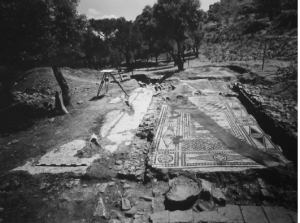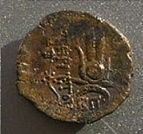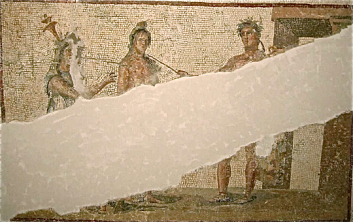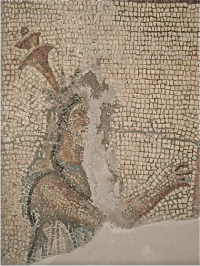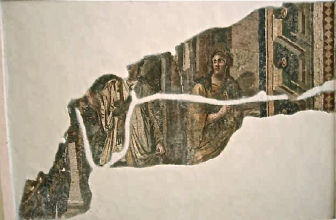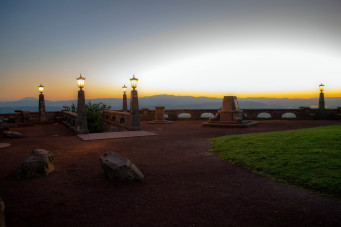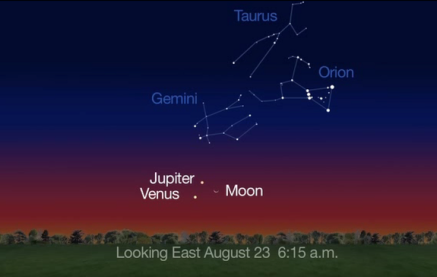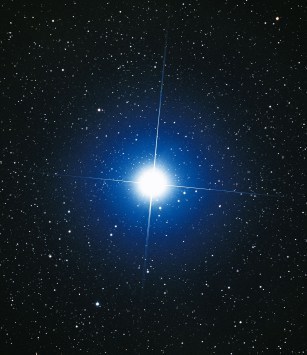M. Isidora Forrest's Blog, page 42
August 30, 2014
The Mysteries of Isis in Antioch
A photo of the site of the House of the Mysteries of Isis in Antioch
Ancient Antioch, modern Antakya, is in Turkey. It was an ancient Greek city, located on the banks of the Orontes River.
Like Alexandria, it was founded by one of Alexander’s generals, Seleucus I Nicator, who also founded the Seleucid Dynasty and ruled over the largest part of the lands conquered by Alexander.
This included Mesopotamia, Armenia, Cappadocia, Persis, Parthia, Bactria, Arabia, and more. Much of the ancient city is still underground, but some has been excavated, revealing a wealth of beautiful mosaics. So why are we talking about this?
Because several of those mosaics have to do with Isis. It is well known that Isis was worshipped in Antioch. Her worship was supposed to have been introduced by Seleucus IV (187-175 BCE), who built an Iseum there for Her, but it may have been even earlier based on the evidence of ancient coins. Images of the Goddess and of Serapis have been discovered, as well as numerous lamps with Isis on them, personal household votive images of the Goddess, and coins with Her head, headdress, or bust.
A coin from Antioch showing an Isis headdress
In ancient Antioch, Isis seems to have been assimilated most strongly with Demeter, Persephone, Aphrodite, and Tyche or Fortuna, as She was in many places, and was preeminently a Goddess of Mysteries.
The locations with the Isis mosaics have been dubbed “The House of the Mysteries of Isis” (in Antioch) and “The House of the Isiac Ceremony” (in Daphne, modern Defne-Yakto, a suburb of Antioch). Perhaps you can see why they caught my interest.
The House of the Mysteries of Isis is just down the hillside from another house with important mosaics, the House of the Bakchic Thiasos. So here again, we find Isis and Dionysos in close proximity; these two houses are, in fact, the only two buildings in the area.
The initiation scene from the House of the Mysteries of Isis; pretty hard to tell what’s going on, isn’t it? You can see Hermes touches the man with a wand as the female figure, likely Isis, gestures.
The largest preserved fragment from the House of the Mysteries of Isis is thought to show the voluntary ritual death of the initiate of Isis (as in Apuleius’ tale of initiation into Her Mysteries).
It appears to show the initiate, being led by Hermes, with wand in hand and caduceus on His shoulder, to his “death” (represented by the doorway), while Isis, possibly enthroned, watches him go. Because of the lack of common Isiac attributes (e.g. sistrum) and the fragmentary nature of the mosaic, we’re not completely sure this female figure is supposed to be Isis; perhaps she is a priestess, a spirit, or a different Goddess. Naturally, there is scholarly controversy over her/Her identification.
In a second room in the same house, a mosaic has been identified as a representation of the Navigium Isidis, the Festival of the Ship of Isis, also described by Apuleius. This would strengthen the case that the female figure in the previous mosaic is intended to be Isis, but there has been controversy over the identification of this scene as well.
Interestingly, the room with the ritual death of the initiate faces west; this is appropriate for the Egyptian tradition that the dead entered The Beautiful West, personified as the Goddess Amentet Noferet. The Navigium scene faces east, perhaps indicating new beginnings. Of course, there may be no significance to the orientation, but if its just chance, it is magically excellent chance.
The thing that looks like it’s on top of Her head is supposed to be an unlit torch that is sort of resting against Her shoulder and appears to be on Her head.
In the ritual death scene, the female figure wears a white peplos, a veil, and a wreath with spiky foliage on it. She holds a torch and reaches out to the initiate. The initiate may be naked but for a headdress and shoulder drape; we can’t tell because the middle of his body is missing.
The ritual mosaic is in a small room, suggesting that it was not intended for any type of group ritual, but was likely intended for the family and may have been commissioned to commemorate the homeowner’s own initiation. One researcher has suggested that the ambiguity of the Goddess figure was purposeful, so that only initiates would know who She was, while non-initiates could simply appreciate the mosaic as a work of art.
This seems like an interesting and reasonably possible scenario to me. This idea may be supported by the fact that none of the figures are labeled with a name, which is uncommon in ancient mosaics.
The mosaic from the House of the Isiac Ceremony is much more straightforward. It clearly shows two female figures, one in Isiac white and one carrying a sistrum. This could easily be a representation of an Isis ceremony in which the homeowner took part and wished to commemorate. Who knows? Perhaps it was even the home of a priestess of Isis.
The mosaic from The House of the Isiac Ceremony; the figure on the right holds a sistrum in her upraised hand
Another mosaic from Antioch is part of a calendar and shows a wreath-crowned woman with libation cup, spear, and with her tunic knotted at the breast similar to the famous Isis knot. It’s hard to read, but may be labeled as “March.” Thus, one of the scholars studying this piece suggested that the figure represented the Navigium, which was held on March 5 and opened shipping for the year.
A calendar mosaic from Carthage shows a figure with a sistrum for November, which was the month in which the festival of Isis’ Search for Osiris was held.
So there you are. We don’t know much about Isis in Antioch, but so far at least, this is the most interesting of the information I’ve been able to find. I hope archeological work continues to go on in Antioch so that we may learn more about Isis in this important city that was so vital in ancient times.
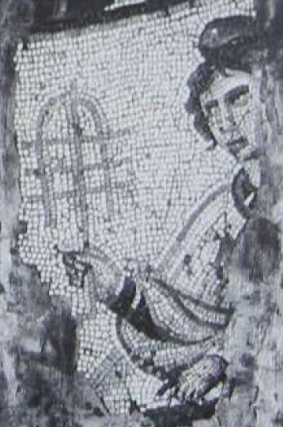
Sistrum-bearing November from Carthage
Filed under: Goddess Isis Tagged: Antioch, House of the Isiac Ceremony, House of the Mysteries of Isis, Isis Demeter, Isis in Antioch, Isis Persephone








August 23, 2014
Isis Risen
Sunrise at the “castle” at the summit of Rocky Butte, our Sirius Rising viewpoint
Wonderful, wonderful.
That’s not what I was thinking when the alarm went off at 3:20 this morning, but it is exactly what I’m thinking now.
I have just come back from witnessing the rising of Sirius, the Star of Isis, in the morning skies over the city of Portland, Oregon. And it was glorious. A fellow priestess of Isis and I traveled to one of the high places in the city to watch Her be born from between the thighs of Her mother Nuet.
Our vantage point is known as Rocky Butte. It is an extinct volcanic cinder cone that rises to an elevation of 612 ft. within the city limits and is a less-than-ten-minute drive from my house. At its summit, there’s a city park surrounded by castle-like walls, which is a popular viewpoint for visitors and natives alike. From Rocky Butte, you can see the slow serpent of the Columbia river that forms the border between Oregon and Washington and the layered silhouettes of the ranges of the eastern mountains, including the archetypal, snow-capped presence of Mt. Hood (though I prefer its Native American name, Wy’east).
When we arrived shortly after 4 am, we could see Orion-Osiris clearly, so we seated ourselves before Him to await Her Rising. We brought stargazer lilies, bread, and milk to offer to Her at Her Appearance, and we each also had that wonder-working wand of modern priestesses, a phone equipped with Google Sky so we could check Her progress toward the horizon. Even though the morning was clear enough, with the haze of the city lights on the horizon, we weren’t certain we’d be able to see Her, but we settled in to wait.
This is what we saw in the pre-dawn sky
Then, to the far left of where the Goddess’ star would rise, we noticed something strange and beautiful. It turns out that this was the one and only morning to see another pre-dawn cosmic wonder: a perfect triangle in the indigo sky of Jupiter, Venus, and the slimmest crescent of the waning Moon. As the triad rose higher in the sky, the crescent turned from ruddy orange to milk white and, from our viewpoint, framed a small stand of fir trees before us on the Butte. It was spectacular. I’ll take that as a portent for the New Year anytime.
At just about 5 am, Google Sky told us Iset-Sopdet should be above the horizon, but we still couldn’t see Her for the city lights, haze, and mountains.
Then—wait, what’s that? Yes, we could see something flashing through the haze, shooting off sparks of red and white and blue-green: Iset-Sopdet appeared. She scintillated. She glittered. She sparkled.
Iset-Sopdet
We watched Her Rising in silence, but for the sounds of the night and the coming dawn.
We meditated, each in our own way. Then, after a time, we poured the milk, offered the bread, and placed the vase of stargazers on the surrounding wall so that they were in alignment with Her star. I really hope someone finds them later today and takes them home to enjoy the incredible fragrance of those lilies. She, I am sure, has already enjoyed them.
The heliacal rising of Sirius, August 23, 2014, was for me, quite simply, a perfect experience.
She is risen.
Filed under: Goddess Isis Tagged: Goddess Isis, Isis, Isis and Sirius, Isis Magic, Isis Sothis, Isis-Sopdet, Jupiter Venus Moon triangle, Orion, Sirius, Sirius rising








August 17, 2014
Isis, Lady of the Holy Cobra

I know, not a cobra…just a cool snake
We are repelled by them. We are fascinated by them.
Beautiful. Elegantly simple. One long muscle sheathed in glossy scales, some like brilliantly colored living jewels, some darkly and dangerously camouflaged.
There was a time when I really, really, really wanted a snake. I did my research. I discovered which kinds were likely to make the best “pets,” if I can even call them that, and how to care for them. Heck, both my Deities have serpentine connections; I should have a snake.
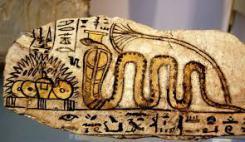
The holy cobra
But in the end, I didn’t get a snake. We already had a fierce black cat and I figured the cat and the snake would pretty much drive each other crazy. Plus, I didn’t want to keep frozen baby mice in the freezer as snake food. Eeesh.
While I may occasionally see a little garter snake in my backyard (and if I come upon it unaware, it can still give me a tiny shiver), the ancient Egyptians came across serpents much more frequently.

The impressive Egyptian cobra
No doubt that’s why serpents of all kinds played important roles in Egyptian mythology—as well as in Egyptian daily life. In myth, serpents were known to be both protective and harmful. In daily life, they were most often frightening due to the many extremely poisonous snakes that make Egypt their home. Two of the most important of these are the Egyptian Cobra, a big, aggressive serpent that can grow to more than two yards in length, and the now-rare Black-Necked Spitting Cobra that can spit blinding venom into its victim’s eyes at a range of more than three yards.

The Black-Necked Spitting Cobra spitting
In ancient Egyptian art, the cobra is most often represented as the uraeus, the fiercely protective serpent seen guarding the foreheads of Deities, kings, and queens. As the uraeus, the cobra is a positive presence, a symbol of the power and protection of the Deities. Uraeus is a Latinized version of the Greek word ouriaos, which is itself a version of the Egyptian word uraiet, which indicates the rearing, coiled cobra. The root word has to do with rising up or ascending, so that uriet, a feminine word, can be interpreted as She Who Rears/Rises Up. The root word is also used to refer to the upward licking of flames. And indeed, the uraeus is often depicted spitting fire. This serpent fire represents both magical fire and the burning pain of the serpent’s venom.
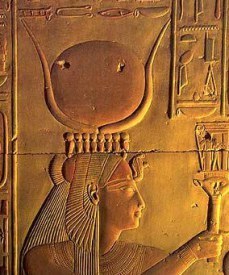
Isis from Abydos wearing a uraeus crown (upholding the horns and disk) and a holy cobra upon Her brow
In the Book of Amduat, an Otherworld guide, twelve cobras blast their fiery breaths to illuminate the paths of the Otherworld for the deceased. In other texts, huge cobras are seen spitting poison in the faces of enemies of the deceased. The uraeus cobras are usually Goddesses, which like the Hindu Shakti, are the active powers of the male Deity on Whose forehead They often sit. Uraei are also sent out as the Eye of the God; so to the cobra’s association with fire, we can add the symbolism of the powerful Divine Eye. With the Egyptian emphasis on transformation and renewal, the cobra’s ability to shed its skin and emerge renewed was symbolically important as well.
Although both Egyptian Goddesses and Gods wear cobras as part of their headdresses, mainly (but not exclusively) Goddesses have a cobra form. In fact, the cobra hieroglyph was often used as a determinative when writing the names of Goddesses or priestesses; and showing a cobra within a small enclosure could indicate the shrine of a Goddess. Cobra Goddesses are numerous in Egypt. The most prominent is Wadjet, the Green One. She is the tutelary Deity of Lower Egypt and one of the Two Ladies Who represent the Two Lands of Egypt. The Harvest Goddess, Renenutet, is a Cobra Goddess, as is Meretseger, She Who Loves Silence, the Goddess Who presided over the Theban necropolis.
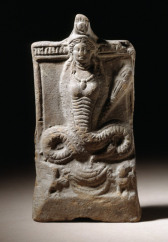
This Egyptian image from about the 2nd century CE shows Isis with a serpent body as Isis-Thermouthis
As a fiery and protective Goddess, Isis also takes the form of a cobra. Sometimes She is the Eye of Re, the cobra-formed, solar power of the God. Sometimes She and Nephthys are shown as two cobras and replace Wadjet and Nekhebet as the Two Ladies of Egypt. Sometimes She is Isis-Thermuthis, a Hellenized form of Isis-Renenutet, the cobra harvest protector.
In Egyptian iconography, cobras are commonly found on Isis’ headdress, while in Greece and Italy, Isis could be shown holding a cobra, or with a cobra wrapped about Her arm. In the Graeco-Roman period, a cobra-formed Isis is paired with Her Graeco-Egyptian consort Serapis (and sometimes Osiris), also in a serpent form. As serpent Deities, Isis and Serapis are Agathe Tyche (Good Fortune) and Agathos Daimon (Good Spirit), and were considered the special protectors of Alexandria. Household serpents, called thermoutheis (pl.) from the name Isis-Thermuthis, were known to be the messengers of Isis.
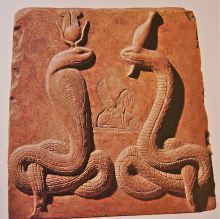
Isis as Agathe Tyche and Osiris as Agathos Daimon in serpent form
Isis is also associated with the cobra in one of Her most famous myths. In the tale, Isis decides to gain power equal to Re’s. The Sun God is old and drools as He continues along His path in the sky. So the Goddess takes up some of His saliva, mixes it with Earth and forms from it a holy cobra which She places along Re’s path. The next day when Re passes by, the holy cobra bites Him. Re experiences pain like never before. He calls upon the Goddesses and Gods to help Him, including Isis. She reveals that She can cure Re if He tells Her His True Name, the most potent magical name in the universe. After much stalling, He eventually relents and tells Isis His Name. The Goddess heals Re and renews Him so that He can continue on His path through the heavens; meanwhile She gains power for Herself—through the magic of a holy cobra. (Please see my discussion of this important myth in Isis Magic and here.)
Have you ever handled a serpent, felt it coil about your wrists or up your arms, exploring with its flicking tongue? If you have, you have touched the beauty of Isis in one of Her most compelling and awe-striking forms.
Filed under: Goddess Isis Tagged: Aspects of Isis, Black-Necked Spitting Cobra, Egyptian Cobra, Holy cobra, Isis and Re, Isis Cobra, Isis Magic, Isis worship today, Isis-Renenutet, Isis-Thermouthis, Sacred serpent, Serpent, Snake








August 9, 2014
Perfumes for Isis
As all my hours are filled this weekend, I offer you this long-ago post on perfumes for the Goddess. At this time when so many of our gardens are filled with blossoms, it seems appropriate.
The Goddesses and Gods of ancient Egypt (and probably everywhere else, too) were always associated with scent. But in Egypt particularly, you knew that a Deity had arrived when you smelled Her or His perfume in the temple air.
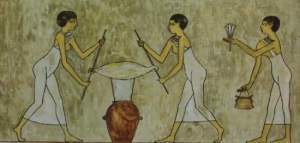
Egyptian women making perfume
The Egyptians apparently blended scents appropriate for their Deities; for instance, there is a record of an unguent called “Aroma of Horus.” Surely, there was an “Aroma of Isis,” too, but alas, we have no record of it to date. Today’s magical perfumers, on the other hand, almost always have a scent for Her. Isis’ association with scent remained part of Her manifestation even after Her worship spread beyond Egypt. In Apuleius’ account of initiation into the Mysteries of Isis, his protagonist sees Isis in a vision and remarks that She breathed forth the “blessed fragrance of Arabia.”
My personal favorite scent for Isis is stargazer lily. With its deep pink, engorged-looking blossoms, stargazers are downright sexual in their showiness. Of course that is exactly what any flower is; sexual. As you may know, flowers are the sex organs of plants, which they display for all the world to see, marvel at, and enjoy. No wonder we have always given flowers as a love gift.
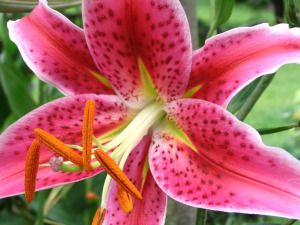
The stargazer lily; thus do we offer unto Isis that which is Hers
I like the blatant, vulva-pink sexual display of the stargazer to be sure. And the flower’s name reminds me of Isis’ own starry connections. But the main reason I associate them with Isis, and give them in offering to Her, is the scent. The stargazer’s soft, sweet perfume is deepened with a dark, funky musk that is almost animal-like in its pungency. The stargazer is my “jitterbug perfume.” (If you have not read Tom Robbin’s Jitterbug Perfume, oh please do!) The mixture of sweet and strange all wrapped up in an audacious package seems to me a perfect floral resumé for Isis. She offers us the sweet love of a mother one moment, then freaks us out completely with some weirdly magical happening the next. Like the flower, She is not shy; never shy. She will always tell you what you need to hear even when you don’t particularly want to hear it. Thus do I offer unto Isis that which is Hers: the beautiful stargazer lily.
The ancient Egyptians had no stargazers, alas. But they did associate a variety of other scents with Isis as well as with other Deities.
Expeditions to Punt for cinnamon, frankincense, myrrh, and other precious resins, were common throughout Egyptian history. The huge gardens attached to the temple complexes also supplied vast quantities of herbs and flowers for the creation of the gallons of scent, pounds of incense, and thousands of bouquets offered in Egyptian temples. Many temples, such as those at Edfu and Denderah, even had special laboratories for making perfume and incense. Perfume was, after all, one of Egypt’s most lucrative exports.
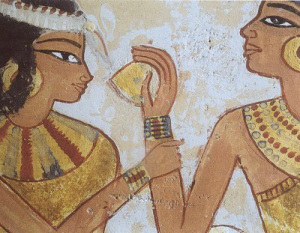
Egyptian women enjoying perfume
Cleopatra VII, the queen who styled herself “the New Isis,” was reputed to use a different perfume for every part of her body and was credited with writing a book on the subject. But Cleo’s perfumes would not have been the clear, alcohol-based liquids we think of as perfume today. Egyptian perfumes were oil and fat-based; similar to our solid perfumes that liquefy as they are rubbed into the skin. A number of Egyptian perfumes were quite famous, the name brands of their day.
Lily was the dominant scent in Susinon, a perfume that seems to have been made exclusively by women. Perhaps this was because the lily was connected with female sensuality and spirituality and lily oil was a common treatment for “female complaints.” Lotus oil, from the sacred blue lotus (actually a blue water lily), was a favorite essential oil and associated with rebirth. It was the fragrance most favored by Egyptian priestesses. Other Egyptian perfumes include Magaleion, a complicated, difficult-to-make scent; Mendesian, known simply as “the Egyptian,” which was a spicy, resinous perfume; Metopion, a mixture of resins, herbs, sweet wine, and honey; and Sampsuchum, a marjoram-based scent sweetened with herbs and nasturtium flowers. And then there was Kyphi, both an incense and perfume.
Recipes for Kyphi perfume are engraved on the walls of the temple of Isis’ son, Horus, at Edfu and at Philae, Isis’ own great temple in Upper Egypt. Kyphi was used especially to welcome the Deities to Their temples. Wine-based, Kyphi also includes sweet flag, rushes, cinnamon, juniper, raisins, myrrh, frankincense, cardamom, and gum mastic. In his essay “On Isis and Osiris,” Plutarch reports 16 ingredients and says that Kyphi calms, soothes, and can lull to sleep. It is also said to sharpen the intuition and promote dreams.
A priestess friend and I once made a ridiculously huge batch of Kyphi from Plutarch’s recipe, which I am still burning to this day. It has a warm smell; like spicy raisin cookies. In fact, you could eat it without harm—and I believe the Egyptians did, medicinally. Luckily for me, it seems to get better with age.

A beautiful piece of stargazer lily art
Filed under: Goddess Isis Tagged: Ancient Egypt, Aspects of Isis, Goddess, Goddess Isis, Isis, Isis and stargazers, Isis Magic book, offering to Isis, Perfumes for the Goddess, Scent for priestesses, Scents associated with Isis








August 3, 2014
Iset Mystikê?
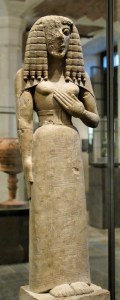
An early Greek Kore, looking very Egyptian, complete with braided wig
Most modern scholars now accept the influence of ancient Egypt on ancient Greece. We are finally able to take ancient Greek writers a bit more seriously when they tell us that—well, yes—the fractious city-states of Greece were indeed impressed and influenced by the ancient-even-then, ever magical, amazingly unified, and seemingly peaceful land of Egypt.
Hey, nobody operates in a cultural vacuum and the ancients didn’t either.
Writing in the 5th century BCE, the Greek historian Herodotus told his readers flatly that in the Egyptian language Demeter is Isis. In fact, he seems convinced that most of the names of the Greek Deities and many of the Greek religious rites came to the aboriginal Greeks, the Pelasgians, by way of Egypt. Among these rites are the famous Greek women’s rites of Demeter called Thesmophoria.
In his essay On Isis and Osiris, the Greek priest Plutarch remarks that “Among the Greeks also many things are done which are similar to the Egyptian ceremonies in the shrines of Isis, and they do them at about the same time.”
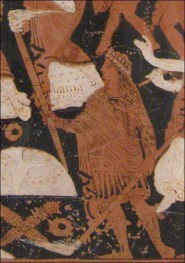
One of the Eleusinian priests, the Dadouchos
Diodorus Siculus, a Sicilian historian, records that Erechtheus, the mythical king of Athens, was himself Egyptian and it was he who instituted the Eleusinian rites after obtaining grain from Egypt during a Greek famine. He also said that the Eumolpids, the family that traditionally ran the Eleusinian Mysteries, were of Egyptian priestly stock.
How seriously should we take this? Could there be an Egyptian seed at the center of the defining Mysteries of ancient Greece, the Eleusinian Mysteries of Demeter and Kore?
It is quite true that we have no incontrovertible proof of an Egyptian origin of the important Eleusinian Mysteries. We do, however, have interesting footprints to follow up. We know for certain that either Egyptians were at Eleusis or that Greeks brought Egyptian talismans to Eleusis for Egyptian scarabs and a symbol of Isis, which date to the ninth or eighth century BCE, have been discovered there. The eighth century is the time to which the Eleusinian rites are usually dated, though it is likely that their true origins go back further, even if the rites were not in the form they eventually took.
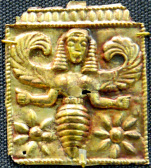
Greek Bee Goddess…in what looks like an Egyptian nemyss.
The correspondences between the Eleusinian myth and the Isis and Osiris myth as related in Plutarch are notable: the search for a missing Divine Beloved, the mournful aspect of the searching Goddess, the connection of the Beloved with the Underworld, and the (possible in the case of Eleusinian myth) birth of a Divine Child. Plutarch’s 2nd century CE rendition of the story is usually seen as Demetrian influence on Greco-Egyptian Isis and Her Greco-Roman Mysteries. But what if it was the other way around?
There are scholars who have traced magical formulae from Egypt to Greece, then followed them as they returned from Greece—changed—to be re-adopted in Egypt at a later period. Perhaps something like that happened with the Eleusinian/Isis-Osiris myth. While the basis of the myth—missing Beloved, searching, mourning, finding—may have its roots in Egypt, by the time it came back to Egypt, it had been changed. For instance, the “weeping at the well” incident in both the Demeterian myth and Plutarchian Isis myth is not found in any Egyptian rendition of the Isis and Osiris tale. It would indeed seem that this revised piece of the story was adopted from Demeter’s myth into that of Isis.
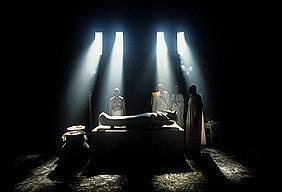
Egyptian death rites as Mysteries
While this is speculative, it’s not just me speculating. There are actual scholars thinking along these lines. One of them is the highly controversial Martin Bernal (author of Black Athena, which traces African origins for a great deal of Greek culture). The much less controversial Walter Burkert has something to say about eastern influence, too, in his The Orientalizing Revolution: Near Eastern Influence on Greek Culture in the Early Archaic Age. Even scholars of a more classical bent admit the influence of Egypt on early Greece, especially in matters of religion.
Bernal’s work as a whole should not be dismissed just because he goes too far in some cases. In my opinion, overall he’s right: Egypt particularly, as well as other long-established near eastern nations, exerted a huge influence on early Greece in its formative stages. Once Greece became established, of course, it developed its unique culture. But again, no culture exists in a vacuum. We are all influenced by each other.
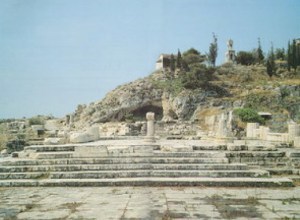
The entrance to the Eleusinian sanctuary today
Bernal spends a lot of time making etymological connections (etymology is the study of word origins) which are, at the very least, interesting. For instance, there are a number of Eleusinian terms that have no Indo-European cognates, yet can be explained in terms of ancient Egyptian or West Semitic. I won’t go into all the details because, if you’re not an etymologist, you might start to snore. One of these terms is the word “mysteries” itself. While it is usually explained as coming from an Indo-European root that refer to “closing the mouth” or staying silent, Bernal suggests that it might be better and more directly explained by an Egyptian root that refers to secrecy.
In this scenario, “mysteries” is derived from ancient Egyptian em sesheta (you can see the “m” and “s” sound there), meaning “in secret.” Sesheta, “secret,” was a word often used in relation to the Isis-Osiris rites, as well as other Egyptian rites.
Bernal also make connections between Greek words associated with the Mysteries and other Egyptian words, but frankly, I don’t have enough etymological background to judge. For instance, Bernal offers a connection between the Greek root of telete (initiation), which also means “completion” with the Egyptian djer, meaning “limit, end, or entire.” (You may recall this word from our discussion of Nephthys as the Lady of the Limit during the last few weeks.)
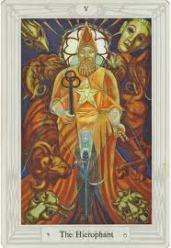
The Hierophant from the Thoth tarot deck; the Hierophant is the High Priest at Eleusis, and of the Eumolpid family
As I mentioned earlier, Diodorus Siculus recorded the tradition that the Eleusinian priestly family, the Eumolpids, were originally Egyptian. The ancient Greek scholar Apollodorus said that the Eumolpids were from Eithiopia. Apparently the Eumolpids themselves believed they had Egyptian origins, while others said they were from Thrace. Bernal suggests that the name Eumolpid, as well as the name of the second Eleusinian priestly family, the Keryxes, who served as Sacred Heralds, have plausible Afroasiatic origins. In fact, he thinks that Greek keryx comes from Egyptian qa kheru, “high or loud of voice.” And that, if true, is extremely cool.
Of course, the big thing that may have come to the Greeks from Egypt is the idea of a blessed life after death. In the work of early Greek poets like Homer, the afterlife is a place of wan grey ghosts and no joy. Where did the idea of a joyful afterlife—for initiates, anyway—come from? Surely, surely it was influenced by Greece’s neighbors to the south, where they were well-versed in the ways of the afterlife and its joys, assuming one knew the proper passwords and pathways. It seems likely that this knowledge, which would have been sesheta until Books of the Dead became more widely available for everyone in Egypt, could have been turned into a Mystery cult at Eleusis, where a Goddess searched for a missing Beloved, eventually found Her, though She was forever changed having become the Queen of the Dead, and then bestowed the Mystery of a blessed life after death on Her initiates.
And we haven’t even gotten to the harmonies between Isis and Demeter, which are much more interesting than just Their “Mother Goddess” connection. Perhaps we’ll go there next time.
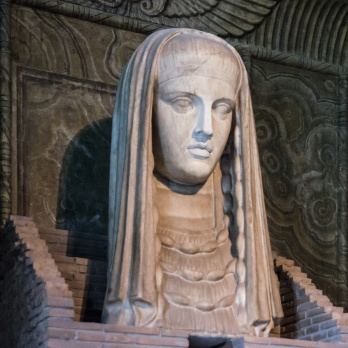
The monumental head of Isis-Sothis-Demeter from the Roman Emperor Hadian’s Villa, now in the Vatican Museum; I have seen Her in person and She is wow.
Filed under: Goddess Isis Tagged: Aspects of Isis, Dadouchos, Demeter, Eleusinian Mysteries, Eleusis, Goddess, Goddess Isis, Hierophant, Isis, Isis and Demeter, Isis Magic, Kore, Osiris, Persephone








July 27, 2014
Isis & Sirius Rising
 Sirius Rising Calculator
Sirius Rising CalculatorMany of you have been searching for information on the Star of Isis and when it rises in your area. So today’s post is a repeat with information on both.
Depending on what latitude you’re at, Sirius could be rising anytime from July to August in the Northern Hemisphere. Here’s link to a calculator:
Go to the Client Area at http://www.culturediff.org/english/clientareatest1.php and then, enter your email and the password softtests.
Isis & Her Star
If you have ever seen the star of Isis, Sirius, through a telescope, you will never forget it. She scintillates. She glows. She shoots off rays of blue, green, pink, and white. Yes, really. Sirius is the brightest star in the night sky, second in illumination only to the sun. No wonder we notice this brilliant and beautiful star. And from at least the time of the Pyramid Texts, if not before, Sirius is connected with Isis.
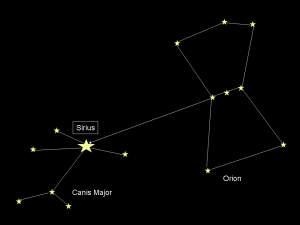
To locate Sirius, look to the left of Orion’s belt
In the sky, Sirius is to the lower left of the extremely easy-to-spot constellation of Orion, which has always looked to human beings like a human torso. Orion has been visualized as a Great Shepherd, Hunter, Warrior, or simply a Giant. And since every shepherd or hunter must have his hunting hound, Sirius itself, as well as the constellation in which it is the lead star, has been envisioned as a Great Dog. Interestingly, this is true in cultures throughout the world, from ancient Mesopotamia to China (where Sirius is a wolf) to Native North American tribes like the Blackfoot, who called it Dog-Face, and the Inuit, who called it the Moon Dog. (The Wikipedia article on Sirius seems to be pretty good and includes references.) Surely it was envisioning Orion as a shepherd, hunter, or warrior that led so many ancient peoples to see Sirius and its constellation as a companion dog.
Sirius cannot be seen during a period of about 70 days, from May to sometime after midsummer. At this time, Sirius and the sun are in conjunction so that the sun’s greater light blocks the visibility of Sirius. The heliacal rising of Sirius is when the star and sun are sufficiently separated so that—for the first time in 70 days—Sirius can be seen on the horizon just before dawn. In the northern hemisphere, this occurs in mid-to-late summer, the hottest part of the year. From Classical times, this period has been known as the “Dog Days” since the Dog Star of Sirius is once again visible. As those suffering through this year’s drought can attest, this hottest time of the year can be miserable. Homer knew it as a time of fevers and suffering. The Romans thought it made dogs act crazy. We think of it as a time when we’re panting like a dog because of the heat.
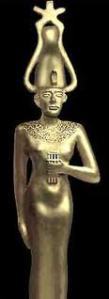
An Egyptian image of Sopdet Who is Isis
In contrast, ancient Egypt didn’t originally connect Sirius with dogs or wolves. It did, however, connect the star with something vitally important—the Inundation, the annual flooding that enabled farmers to grow the crops required for Egypt to feed itself. The heliacal rising of Sirius was the herald of the Nile flood and its rise marked the beginning of the New Year; thus Sirius (Sopdet in Egyptian) was called the Fair Star of the Waters and the Opener of the Year. In Egypt’s earliest written records, the Pyramid Texts, Sopdet is Isis: “Your sister Isis comes to you [Osiris] rejoicing for love of you. You have placed her on your phallus and your seed issues into her, she being ready as Sopdet, and Hor Sopd has come forth from you as Horus who is in Sothis [the Hellenized version of the Egyptian Sopdet].” To acknowledge the Goddess’ ancient connection with Her star, some shrines and temples of Isis, including the small Isis temple at Ptolemaic-era Denderah, were oriented towards Sopdet.
When Egypt came under Greek and then Roman rule, Isis got Her canine connection. In a later-period aretalogy (self-statement) from Kyme in modern Turkey, Isis says of Herself, “I am she that riseth in the Dog Star.”
Just as Orion the hunter is inseparable from his hound, so the Egyptians saw a connection between the constellation they called Sah (Orion) and the most brilliant star in the heavens, Sopdet. Sah could be identified with Osiris Himself or considered to be His soul. Sopdet was identifed as Isis (as in the text above) or as Her soul. As Orion rises before Sirius, you can see the ancient myth of Isis searching for Her lost husband played out before you as the constellation Orion appears to move through the sky ahead of the Beautiful Star.
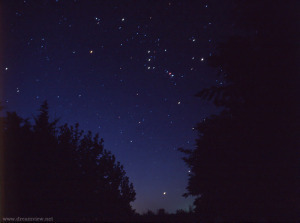
Osiris on His back (note the position of the three belt stars) with Isis-Sopdet below (framed by the trees), upraising Him
Yet there is another interpretation of the movement of the stars through the sky that takes us to an even more important point in the Isis-Osiris myth. You see, when the Orion constellation first appears on the horizon, Osiris seems to be on his back, with Isis-Sopdet rising beneath Him. As the night passes and the constellation rises higher into the sky, He “stands up,” with Isis at His back all the while, pushing upward until the God is raised. Even more so than the myth of Isis following Osiris to pick up the pieces, we can see the rising of Orion and Sirius as Isis raising Osiris from the dead, the stellar model of the ritual of Raising the Djed Column, which the pharaoh, with the help of Isis, performed on earth.
Filed under: Goddess Isis Tagged: Aspects of Isis, Dog Star, Goddess Isis, Isis, Isis & Sirius, Isis Magic, Osiris, Rising of Sirius, Sirius, Sirius Rising Calculator, When does Sirius rise?








July 26, 2014
Join me on GoddessAliveRadio this evening & a Sirius Rising Calculator
 Please join me for a New Moon Meditation on GoddessAliveRadio this evening at 8pm eastern, 5 pm pacific. Here’s what we’ll be meditating on…
Please join me for a New Moon Meditation on GoddessAliveRadio this evening at 8pm eastern, 5 pm pacific. Here’s what we’ll be meditating on…
On this night of deepest darkness, we invoke Iset-Sopdet, Isis-Sothis, Isis the Lady of the Beautiful and Brilliant Star of the Goddess, Sirius. We open our hearts to Her blessing. Oh yes, we make bare our hearts before Isis the Goddess. We illuminate our hearts in Her diamond starlight. And on this dark and deep and star-filled night of new moon in Leo, She imparts to us some of Her strength and Her power and Her courage.
I’ll be talking with your hosts, Kimberly Moore and Tracey Paradiso, about Isis, of course…and who knows what else we’ll get into.
Here’s how you can tune in: Check out the promo here at the MotherHouse (love that; like the MotherShip).
And you can listen live at this link.
Or dial in from your phone: (347) 945-5979. I believe they take questions. Whether or not I’ll be able to answer them is another thing entirely.
Rising of Sirius Calculator UPDATE
A number of people have been looking for the Sirius Rising calculator…and it has been located by the wonderful Tatiana. Here are her instructions:
You need to go to Client Area http://www.culturediff.org/english/clientareatest1.php
and then, enter your email and password softtests.
That last bit—softtests—is the password ;)
May your celebration of the Rising of Sothis be brilliantly beautiful!
Filed under: Goddess Isis Tagged: Goddess Alive Radio interview, Interview with Isidora Forrest, Isidora Forrest, Isis & Sirius, Isis-Sopdet, M. Isidora Forrest, Rising of Sirius, Rising of Sothis, Sopdet








July 23, 2014
Join me on GoddessAliveRadio this Saturday & Sirius Rising
 Please join me for a New Moon Meditation on GoddessAliveRadio this Saturday at 8pm eastern, 5 pm pacific. Here’s what we’ll be meditating on…
Please join me for a New Moon Meditation on GoddessAliveRadio this Saturday at 8pm eastern, 5 pm pacific. Here’s what we’ll be meditating on…
On this night of deepest darkness, we invoke Iset-Sopdet, Isis-Sothis, Isis the Lady of the Beautiful and Brilliant Star of the Goddess, Sirius. We open our hearts to Her blessing. Oh yes, we make bare our hearts before Isis the Goddess. We illuminate our hearts in Her diamond starlight. And on this dark and deep and star-filled night of new moon in Leo, She imparts to us some of Her strength and Her power and Her courage.
I’ll be talking with your hosts, Kimberly Moore and Tracey Paradiso, about Isis, of course…and who knows what else we’ll get into.
Here’s how you can tune in: Check out the promo here at the MotherHouse (love that; like the MotherShip).
And you can listen live at this link.
Or dial in from your phone: (347) 945-5979. I believe they take questions. Whether or not I’ll be able to answer them is another thing entirely.
Rising of Sirius Calculator UPDATE
A number of people have been looking for the Sirius Rising calculator…and it has been located by the wonderful Tatiana. Here are her instructions:
You need to go to Client Area http://www.culturediff.org/english/clientareatest1.php
and then, enter your email and password softtests.
That last bit—softtests—is the password ;)
May your celebration of the Rising of Sothis be brilliantly beautiful!
Filed under: Goddess Isis Tagged: Goddess Alive Radio interview, Interview with Isidora Forrest, Isidora Forrest, Isis & Sirius, Isis-Sopdet, M. Isidora Forrest, Rising of Sirius, Rising of Sothis, Sopdet








July 19, 2014
Greeting Nephthys
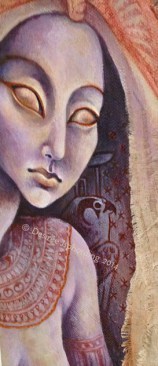
A contemporary Nephthys by artist Desiree Isphording. You may purchase this piece on etsy.
This time I’d like to share two things: a thought on how Isis and Nephthys may relate to each other in light of what we talked about last time and a meditation/vision I had with Her.
The vision has particularly struck me and hasn’t quite left since. It may or may not strike you; we’ll see. Even better, perhaps you will have your own vision with the Lady of the Limit.
First, you may remember the idea of Isis, the Goddess “Throne,” as the first Something that came into Being:
In the Coffin Texts, the Creator God Atum says He was “alone in lassitude” in the Nu, the Primordial Chaos, and describes it as a time “when my throne had not yet been put together that I might sit on it.” Here, the throne is a symbol of everything. With the coming together of the throne is the coming into being of all things. Thus, I believe we can say that the Goddess Throne is the Goddess of Existence. She is the seat not only of the king, but of all things. Without the Throne, nothing exists but the Primordial Chaos and the Divine consciousness.
The Goddess Throne is the Seat, the Abode, the Place; but importantly, She is The First Place, the First Holy Point of Being, the Sacred Something that First Came Into Existence from Nothing. The Goddess Throne is the One Who First Came Into Being and She is also the Divine Creatrix, the One Who Brings Into Being.
.
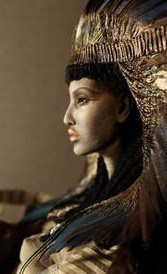
The Lady of the Limit, Encircler, Surrounder
If Isis is the point in the center of the circle, so to speak, perhaps Nephthys is the holy wall that surrounds and encloses the point. Isis is the Beginning, Nephthys is the End or Limit. And because the space that Nephthys encloses is not just any space, but sacred space—temple space—it is specially set-aside and protected and may serve as a place of contact with the perfection of First Creation as well as with the Goddesses and Gods. And indeed, that is, in many ways, how the ancient Egyptians envisioned their temples.
A Visit to the Temple of Nephthys
The doors are nearly half-a-story tall, of dark wood, and plainer that I would have expected. As I stand before them, they swing outwards, pivoting smoothly on their hinges. I enter Her temple.
In contrast to the sandstone-red desert outside, inside is a living jungle. Palm trees, lush wetlands, lotus flowers blooming everywhere; they open their inner hearts to me as I pass by. The Great Above is a beautiful shade of twilight in the Temple of Nephthys. The temple ceiling—or is it the sky?—is deep indigo blue, as deep as the most precious lapis lazuli and flecked with diamond stars.

The twilight jungle inside Her temple
I am immediately aware of all the living creatures around me. An enormous crocodile wanders by, yawning, showing its teeth. A huge serpent moves, seeming to flow past, yet taking no notice of my presence. I am a bit disconcerted by all this dangerous life. But the voice of the Goddess says, “They are satisfied.” At the time, these words of the Goddess did not penetrate home to me. Later, they did. A little. They were hotep, “satisfied;” they felt no need to snack on me; I need not be afraid. And yet, I think that I have not yet quite unpacked that whole interaction. There is a mystery in the hotep-ness of the beasts that will come.
They live within Her temple. They exist in Her primordial perfection—for indeed, that is what Her temple encloses, encircles, surrounds: Primordial Perfection, Paradise—the Garden, the First Place, the Mound That First Arose from the Nun, the Ancient Chaos. It it still muddy and moist. And it is beautiful; as beautiful as you could ever want, as beautiful as you could ever imagine. It exists in dark warmth and deep blue twilight. Life burgeons within. Satisfied.
I know I should go to Her, find Her within Her temple. So I walk on and, of course, soon come to Her throne room, for She is indeed seated upon a throne.
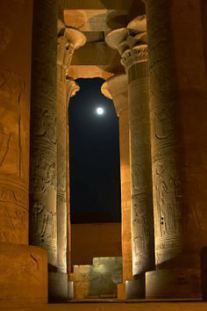
Temple by full moonlight
I approach, kiss the ground before Her beautiful face. I can’t quite “see” Her fully. She seems to exist in an indigo cloud as well. I sense dark blue and black with glimmers of red and gold. She does not leave Her throne as we talk.
I ask Her about Her relationship with Isis and how it came to be. She tells me that, first of all, the Goddesses are all sisters and so, of course, She is the sister of Isis. She also tells me something that, as far as I know, has not been suggested by any scholar to date, so I won’t share it for now. More research is required. (I can sense Her laughing a little in my head as I type this.)
Now for this next bit, you have to know that I’ve been working on shapeshifting and having a certain amount of difficulty with it. And that by “shapeshifting” I mean taking on the astral or imaginal form of a sacred animal, in this case, the sacred kite of Isis and Nephthys, and then employing that form to explore.
Nephthys, in a very sisterly way I may add, says that She is a better shapeshifter than Isis. She shows me a particular, somewhat uncomfortable, posture. And almost instantly I am shapeshifted (all but my feet, which wouldn’t quite go there). I am Kite. Glossy brown feathers, sharp beak, weird side-of-the-head vision, light avian bones. Not wanting to leave the Goddess, I don’t fly away, but She invites me to come back for more lessons. And I will. I let my form, my kheper, melt back to my own.
That’s most of my visit to Her temple. I’ve been back several times since. I have been trying to sense the differences between Her and Isis. Overall, She feels a bit wilder, more shamanic, if I may use that term. But even in Her wildness, She does not seem erratic; it’s not that kind of wildness. She is wild in the way that Her overgrown temple is wild, She is close to the Primordial, but it’s a paradisiacal, encircled, and surrounded Primordial that She has created or delimited in order to interact with us.
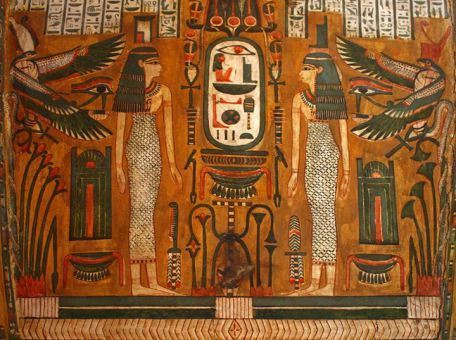
The Two Sisters
Ha! Here’s a footnote to this…I just ran across a little piece of paper on which I had scribbled a note a while ago. It is another name for the Two Sisters. They are also called the Herti, the Two Pacified, Peaceful, or…wait for it…Satisfied Ones.
Filed under: Goddess Isis Tagged: Aspects of Isis, Deities, Egypt, Egyptian Temples, Goddess, Goddess Isis, Goddess worship, Isis & Nephthys, Isis Magic, Nephthys, spiritual vision








July 13, 2014
Oh yes, more Nephthys
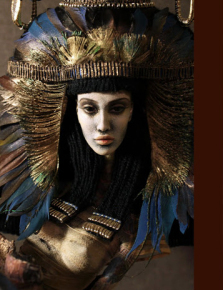
“Nephthys” by the Popovy sisters
Since we last met, I have become quite involved with Nephthys. It seems I shall have more to say about Her.
O, She is a Hidden One. In the Book of Caverns (an afterlife text), She is even described as the one Whose “head is hidden.” Yet She reveals Herself when you pay attention, when you search, when you ask.
Remember that lovely image of Nephthys by the two sister artists in last week’s post? Well, I found a couple more shots of it. Turns out the artwork is stranger and more unexpected than you would have thought having seen just the first photo.
Nephthys Herself is like that. She is stranger, more intriguing, and indeed more beautiful and powerful than you might, at first, think.
When we first read our Egyptian mythology, we see loyal Nephthys always in Her more dramatic sister’s shadow. She assists Isis with Osiris and Horus; She gets stuck with the troublesome, rowdy, and too-dry-to-be-fertile Set for a husband. As I mentioned last time, we used to think She didn’t even have Her own temples. But She did. And Her own priesthood, too.
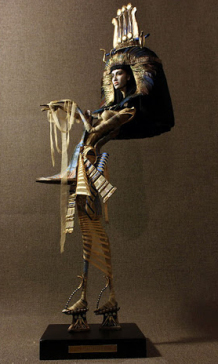
The whole Nephthys sculpture…not what you expected? Me neither.
When in a dyad with Isis, Nephthys is decidedly the “darker” one. The Pyramid Texts advise the king to “descend with Nephthys” in the Barque of the Night, but arise with Isis in the Barque of the Day. Nephthys speaks and the pathways of the Otherworld are obscured. The one being reborn is to “throw off the tresses of Nephthys” like he throws off his mummy wrappings at his rebirth. (I refer you back to a post on the magic of hair in Egyptian funerary ritual.) Nephthys is called Keku, Darkness itself. She is the Lady of the West, She is “in the Cemetery,” She is Lady of the Duat (the Underworld), Mourner and, like Her mother Nuet, She is called “Coffin.” She shares a number of these epithets with Isis (Who can be quite as dark as Her sister when She so desires).
Some researchers see Her darknesses and consider Sad-at-Heart Nephthys to be Death Itself and specifically the first half of the death process—the dying part, the entering into death part that does indeed make us sad at heart. Plutarch records that one side of the sistrum was decorated with Isis’ face while the other had Nephthys’ face, symbolizing creation and death respectively. (On Isis and Osiris, section 63)
It is an interesting and useful identification—and you can certainly make a good case for it. Yet it doesn’t quite satisfy me. Not that Death isn’t a Big Thing. Death is possibly the Biggest Thing we face in our lives—outside of being born itself. But because it is so big, many of the Egyptian Deities are Death Deities. For instance, we could certainly consider Amentet to be Death Herself for Amentet means “The West,” that is, the Egyptian Land of the Dead and Amentet is often called the Beautiful West and welcomes the dead to Her realm.
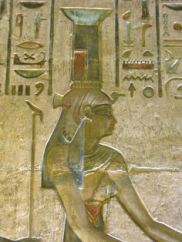
A classic Nephthys
Death is among the concerns of many Deities and it is indeed an intimate concern of Nepththys. But we’re not there yet. Where else can we look for Nephthys?
One place some scholars have looked is Her connection with other Deities. One of the more interesting ones is Her surprisingly close connection with Seshat, the Lady of Books, the Mistress of Builders.
Yeah, I know. Not the first one that would come to mind, is it?
As early as the Pyramid Texts (the oldest ones date from 2400-2300 BCE), Nephthys is said to have “collected all your members for you in this Her name of Seshat, Lady of Builders.” (Pyramid Texts, Utterance 364) Her much-later hymn from Komir invokes Her as “Seshat the Great, Mistress of Humanity, the Mistress of Writing, the Lady of the Entire Library. To You, Who utters divine decrees, Great of Magic, Who rules in the Mansion of Archivists.” There may be Isis-Nephthys parallelism in this spell from the Book of the Dead in which the deceased is seated beside the Great of Magic (possibly Isis) while Seshat (possibly Nephthys) is seated before him or her: “Thou coolest thyself on the cedar tree beside the Great of Magic, while Seshat is seated before thee and Sia [Divine Perception] is the magical protection of thy body.” (Book of the Dead, Spell 169)
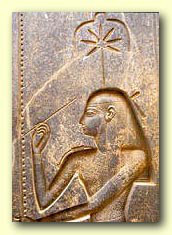
In Her name of Seshat, Lady of Builders
A Ptolemaic text from the Denderah temple says that Nephthys is “She who reckoneth the life-period, Lady of Years, Lady of Fate,” which Seshat does for the Pharaoh by a primitive method of marking notches on a palm rib. (This, of course, brings us back once again to Nephthys association with death.)
The Coffin Texts say, “O , Horus has protected you, He has caused Nephthys to put you together, and She will put you together; She will mold you in Her name of Seshat, Mistress of Potters, for such is this great lady, a possessor of life in the Night-barque, Who raises up Horus, and She will bring to you.” (Coffin Texts, Spell 778) Texts at Edfu and Kom Ombo also record Seshat as a form of Nephthys. (However, it is well worth noting that Isis and Seshat were assimilated as well; which should remind us that, when it comes to Egyptian Deities and when it comes to spirituality, nothing is ever completely without contradiction or complication.)
The priesthoods of Nephthys and Seshat seem to have overlapped in places, too. Nephthys is married to Set and is the mother of Anubis with Osiris; interestingly, we have records of a priest of Seshat who served both Set and Anubis—and who was also in charge of “controlling the foreigners.” More on that in a minute.
The most complete discussion of Nephthys-Seshat (that’s available in English and accessible via your library, if your library is subscribed to Jstor) is in a paper by G.A. Wainwright from the 40s called “Seshat & the Pharaoh.”
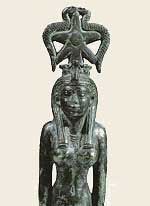
A Seshat with a five-pointed star and two serpents forming Her headdress
He proposes that both Seshat and Nephthys were so old by the Old Kingdom that They were already starting to be forgotten and that Nephthys may have originally been rather Hathor-like, having been a Sky Goddess and a Love Goddess and a Victory Bringer (think Goddesses like Inanna and Ishtar, Who are involved in both love and war and are connected with the planet Venus). Plutarch, in the 2nd-century CE, noted that some called Nephthys Teleutê (“End”; more on that shortly), others Aphrodite, and some Nikê (“Victory”). (Plutarch, On Isis and Osiris, section 12) Nephthys got renewed life by being brought into the Isis-Osiris cycle, while Seshat came into the counting house of pharaoh and became connected with Thoth.
A Nephthys-Seshat connection that doesn’t seem to have been made by anyone I’ve read so far jumped out at me right away. So…speculation alert; here we go.
As Lady of Builders, one of Seshat’s main functions is to lay out the boundaries for new buildings, especially temples, via the ceremony of “stretching the cord,” which was a method of using a cord or rope to measure out straight foundations for a building. She is Goddess of architecture, math, and accounting, as well as being the Divine Scribe. Broadly, these are concerns of delineation, creating limits, setting boundaries, deciding what is in and what is out. Keep that in mind as we go on to the next part.
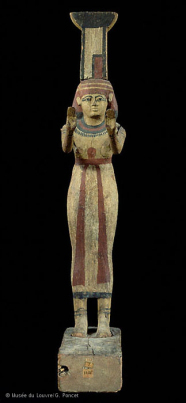
A statuette of Nephthys with Her name glyph showing the neb basket and the temple “blueprint”
Next, let’s look at Nephthys’ name. In Egyptian, it’s Nebet-Hwt, the Lady (Nebet) of the Temple (Hwt). You will also see it as Lady of the House. “House” is one translation of hwt, but that translation has, for most of us at least, connotations of the home or household—but Nephthys has little in Her of Hestia or Vesta. More usually, hwt means a mansion, temple, or even tomb. (Remember those ?)
The hieroglyph for Nephthys’ name combines two other symbols: a neb bowl placed on top of the hwt sign, which is a rectangular sign with a little square or rectangle in the lower right. The neb glyph represents a wickerwork basket and conveys concepts such as “lord” (neb) or “lady” (nebet with the feminine t ending) and “all” or “every.” My guess is that because neb meant “all” it was also used to refer to the ruler of all, the lord or lady. Gardiner (Egyptian Grammer) says the hwt glyph is an “enclosure seen in plan,” in other words, we’re sort of looking down at a blueprint for a building.
What better name glyph for the Lady of Builders than one that represents the blueprint of a building? The Lady of the House—the Goddess with a blueprint in Her name—is also the architecture Goddess Who delineates the foundations of all buildings—but especially the sacred houses of the Deities, the temples.
At Denderah, we even find an ibis-headed Nephthys, which only strengthens the connection between Nephthys and the Divine Scribe, this time with the Divine Male Scribe, Thoth (Sesh), rather than the Divine Female Scribe, Seshat.
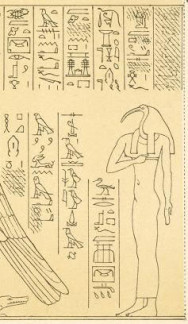
The ibis-headed Nephthys from Denderah; I’m working on finding the hieroglyph translations…but you can see Her name above Her head
Now, let’s go back to Plutarch’s comments about what people in his time called Nephthys: Teleutê. In Greek, it means ending or completion. Plutarch says,”They give the name Nephthys to the ends of the earth and the regions fringing on mountains and bordering the sea. For this reason, they call Her Teleutê and say She cohabits with Typhon [Set].” (On Isis and Osiris, section 38) Later he says that Nephthys is what is “below the earth and invisible” in contrast with Isis Who “is above the earth and manifest.” (On Isis and Osiris, section 44) Both statements speak of Nephthy’s mystery and liminality. She is the border between here and there, then and now, in and out. And if She is that border, She also controls it. The priest of Seshat mentioned earlier was also “controller of the foreigners” and Nephthys’ husband Set is God of foreigners and foreign lands; thus the Goddess and God delineate or “draw the line” between us and The Other.
An Egyptian epithet of Nephthys calls Her Nebet-er-djer Em Em Netjeru, which Tamara Suida translates as “Lady to the Limit Under the Gods.” (Thank you, Tamara for your booklet on Nebt-het…and most especially those epithets.) There’s also a God called Neb-er-djer, which I’ve seen translated as Lord to/of the End or Lord to/of the Utmost, so we may also translate this Nephthys epithet as Lady of the End (Teluetê again!) or Lady to the Utmost Em Em (“among”) the Deities. Here again, Nephthys is the border, the line, the limit between “all of this” and whatever is beyond the End, the Limit, the Utmost.
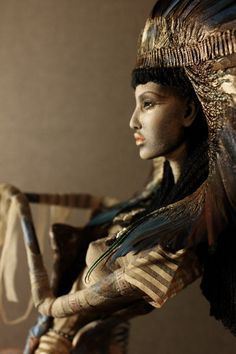
The Nephthys again, just because
As you probably figured out, djer in Egyptian is “end” or “limit.” Faulkner (Middle Egyptian) thinks djeri may mean an enclosing wall, a djeru is indeed a boundary, and the djerty are the Two Kites, Isis and Nephthys. This last, the Djerty, may mean nothing other than being an interesting coincidence. On the other hand, perhaps we can think of the Two Djerty circling aloft, delineating a space in the heavens—one that may even be reflected on earth, for example, as They protectively encircle the body of Osiris as He awaits rebirth.
Now let us come back once more to the Lady of the Temple. What are temple walls but the boundary and the limit between sacred and profane? Thus it is Nephthys, the Lady of the Temple, Who founds and builds the temple walls, enclosing the sacred within, setting it aside as special, protected, and preserved.
Whew! I’m stopping now. I think I’ve must have worn us both out for today. Yet this is just part of what’s been going on with Nephthys and me lately. I have one more thing, of a more personal nature, that I’d like to share with you. But that will wait till next week. In the meantime, may the Lady of the Limit walk beside you and protect you whenever you find yourself at those strange boundaries between Here and There.
Amma, Nebet-hwt.
Filed under: Goddess Isis Tagged: Aspects of Isis, Aspects of Nephthys, Denderah, Goddess Isis, Isis, Isis & Nephthys, Isis Magic, Nephthys, Nephthys and Seshat, Plutarch, Seshat, Teluetê, Wainwright









